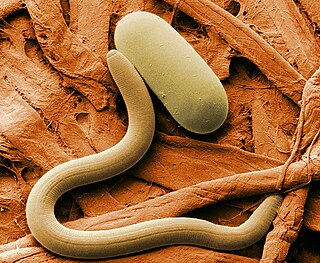
The soybean cyst nematode (SCN), Heterodera glycines, is the most devastating pest to soybean crop yields in the U.S., targeting the roots of soybean and other legume plants. When infection is severe SCNs cause stunting, yellowing, impaired canopy development, and yield loss. The symptoms caused by SCNs can go easily unrecognized by farmers—in some cases there are no warning symptoms before a loss of 40% of the yield. Due to the slight stunting and yellowing, many farmers may mistake these symptoms as environmental problems when in fact they are SCNs. Another symptom of SCNs that may affect farmers' yields is stunted roots with fewer nitrogen-fixing nodules. Due to the fact that soybean cyst nematodes can only move a few centimeters in the soil by themselves, they mostly are spread via tillage or plant transplants. This area of infection will look patchy and nonuniform making diagnosis more difficult for farmers. They can be seen in the roots of summer soybean plants if the roots are taken out very carefully and gently washed with water. The egg masses should be seen as bright white or yellow "pearls" on the roots. The later the roots are pulled the harder it will be to diagnose due to the SCNs female dying and turning a much darker color, forming a "cyst". The best way to know if a field is infected by soybean cyst nematodes is to take a soil sample to a nematologist.

Heterodera avenae, the cereal cyst nematode or European cyst nematode, is a plant pathogen and an obligate parasite of cereal crops including barley, oats, wheat and rye. Cereal crops infected with this nematode are more susceptible to infection by fungal diseases such as rhizoctonia root rot.
Heterodera carotae is a plant pathogenic nematode commonly known as the carrot root nematode or carrot cyst nematode. It is found in Europe, Cyprus and India and is considered an invasive species in the United States. It causes damage to carrot crops and is very specific in its choice of hosts, only infecting Daucus carota and Daucus pulcherrima.
Heterodera goettingiana, the pea cyst nematode, is a plant pathogenic nematode affecting peas.
Heterodera latipons, the Mediterranean cereal cyst nematode or wheat cyst nematode, is a plant pathogenic nematode.
Heterodera rosii is a plant pathogenic nematode that attacks chickpeas.

Heterodera schachtii, the beet cyst eelworm or sugarbeet nematode, is a plant pathogenic nematode. It infects more than 200 different plants including economically important crops such as sugar beets, cabbage, broccoli, and radish. H. schachtii is found worldwide. Affected plants are marked by stunted growth, wilting, yellowing, decreased yields, and death. While there are many methods of control, crop rotation with non-susceptible plants is preferred.

Heterodera is a genus of nematodes in the family Heteroderidae. Members of the genus are obligate parasites and different species attack different crops, often causing great economic damage. The genus is unique among nematode genera because of the ability of the female to transform into a tough, brown, cyst which protects the eggs which have been formed within her body. The name heterodera "refers to the different 'skins' of female and cyst."
Heterodera sacchari, the sugarcane cyst nematode, mitotic parthenogenic sedentary endoparasitic nematode. This plant-parasitic nematode infects the roots of sugarcane, and the female nematode eventually becomes a thick-walled cyst filled with eggs. Aboveground symptoms are species specific and are similar to those caused by other Heterodera species. Symptoms include: stunted and chlorotic plants, and reduced root growth. Seedlings may be killed in heavily infested soils.
Cereal cyst nematode (CCN) is a plant pest caused by Heterodera avenae, Heterodera bifenestra, Heterodera hordecalis, Heterodera latipons, and Heterodera gotland in the following hosts: Avena sativa, Hordeum vulgare, Secale cereale, Triticum aestivum, and × Triticosecale.
Heterodera bifenestra is a plant pathogenic nematode, that is a causal agent of the cereal cyst nematode.
Heterodera oryzae, the rice cyst nematode, is a plant pathogenic nematode, which is cited as an invasive species.
Rice cyst nematode is the common name for several species of invasive plant-pathogenic nematodes:
Heterodera medicaginis, the alfalfa cyst nematode, is a plant pathogenic nematode which is cited as an invasive species. It is closely allied to Heterodera daverti, H. glycines and H. sonchophila in the H. schachtii-group. The only known host plant of this obligate parasite is the important crop alfalfa or lucerne, Medicago sativa.
Heterodera oryzicola, the rice cyst nematode, is a plant pathogenic nematode, which is cited as an invasive species.
Heterodera delvii is a plant pathogenic nematode, who is cited as an invasive species.
Heterodera elachista, the Japanese cyst nematode or rice cyst nematode, is a plant pathogenic nematode, which is cited as an invasive species.
Heterodera zeae, the corn cyst nematode (CCN), is a plant parasitic nematode that feeds on Zea mays (maize/corn). The CCN has a limited economic impact worldwide due to its high soil temperature requirements.
Pasteuria nishizawae is a mycelial and endospore-forming bacterium parasitic on cyst nematodes of genera Heterodera and Globodera.


